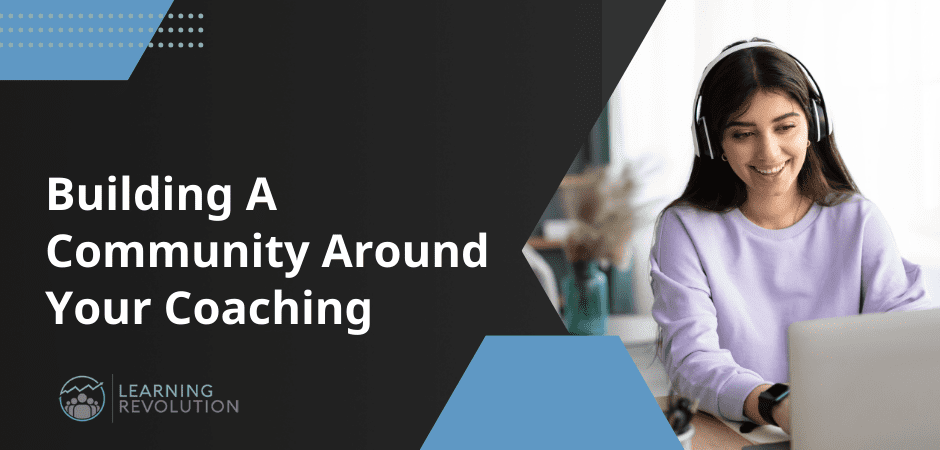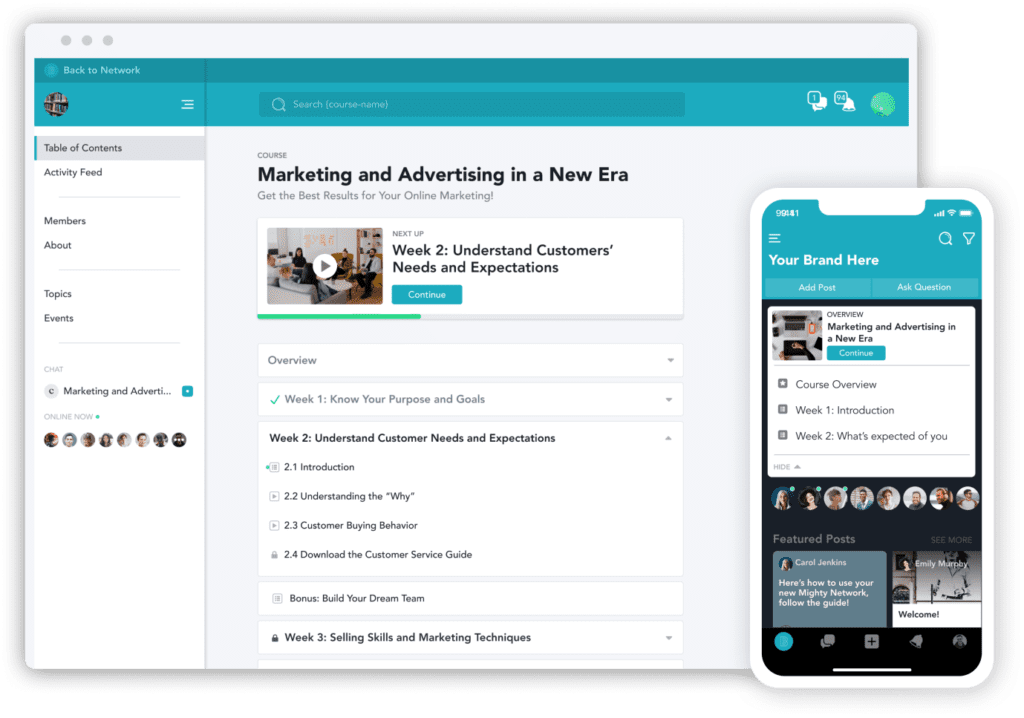

Below you’ll find the video for and a transcript of a virtual conference session I delivered on how to build a learning community.
I’m sharing it here on Learning Revolution because I think that building community is one of the most effective approaches edupreneurs can take for creating a truly sustainable education business – particularly in the current environment and with the great online community platforms now available.
While there is a lot of focus on selling online courses these days, there is also more competition than ever. And, let’s face it, most people don’t want to take courses all the time. Once they finish yours, they may move on and never be heard from again if you don’t have a way to provide ongoing connection and value.
That’s what a learning community can make possible.
So, here’s the video and below it you will find the transcript and a table of contents.
Table of contents
Hey there, it’s Jeff Cobb from Learning Revolution. And in this World of Learning session from LearnWorlds, we’re going to talk about why and how to build a learning community. I think it’s one of the most important things that course creators can be doing these days to thrive in the current online course marketplace. By the end of this session, you’ll have an understanding of what that involves, and also some concrete next steps to take. Let’s go ahead and dive right in.
Let’s just highlight quickly what we’re going to cover in this session.
We’re going to talk about the definition of community. Often, it’s not what people think it is, so we want to be clear about what we’re aiming for here.
We’re going to talk about the value of community, so really why you want to create a learning community.
We’ll talk about the keys to doing that – how to actually build a learning community.
We’ll show some examples of community.
And then finally, we’ll touch briefly on monetizing community since that’s likely something that’s on everybody’s mind here.
What is Community?
To start off with, what is community? What do we mean by this exactly? And it may be easiest to start with what community is not.
In the first place, just having an email list, as important as that is – and it is extremely important – but just having that email list is not the same as having a community. Email is obviously pretty much a one-way medium, a broadcast. You may have some interaction with your users by email, but you’re not really going to be able to form any sort of scalable community just by using email.
Now, the next one that might seem closer is membership. If you have a membership website where people are signing up to receive access, receive content over time, that’s still not really a community. You’re going to have to be able to take it a step further than just that subscription to really be able to call it a community.
And there are a lot of people out there who have, a big e-mail list and say they have a community, a lot of people who have memberships or platforms that say that they will give you membership capabilities and refer to that as community.
It really isn’t.
What do we mean by community? What are we actually shooting for here? Well, this is a standard definition from the Oxford Dictionary, and it’s actually the secondary definition, but it’s the one I really like:
a feeling of fellowship with others, as a result of sharing common attitudes, interests, and goals
Oxford Dictionary
And this is really what you’re shooting for with community.
I like for example, that it talks about a feeling. A community is something much more than transactional. People feel it. They know it. There’s an emotional connection when you are in a community. There is that sense of fellowship.
Connection might be the more modern way to put that. But you have an affinity with the other people who were there. They may not be your best friends forever, your BFFs, but nonetheless, you’re connected with them in a serious way and that’s because you do share those common interests. And in the case of course creators, it’s usually the interest in whatever topic you happen to address.
They share common goals because they are trying to achieve similar things by learning the things that you’re teaching and that you’re helping them learn. And then, importantly, they do share a certain commonality of attitude. They’re probably going to be, in a lot of cases, entrepreneurial in spirit, curious. They’re going to have some common values, some common motivations and some common attitudes that they’re sharing.
These are the types of things that you’re really looking for in a group of people to not just be a list, not just be a subscription, but to really be a community.
Why is Learning Community Valuable?
Why is this type of learning community something that’s so valuable?
Well, there are essentially three key reasons in my mind, and you can probably come up with more, but these are three essential reasons why a learning community is so valuable in our current landscape.
It’s a way to differentiate
Now, the first one is that community is a way for you to really be able to differentiate and compete in a world where that’s getting much harder. Five years ago, certainly 10 years ago, it wasn’t all that common to find online courses other than in the corporate training marketplace or in the academic marketplace. But these days it seems like really everybody and their mother has an online of course out there.
This is a screenshot from Udemy, which I think of as the marketplace, really the commodity place for online courses. And you can see that Udemy is saying it’s got more than 100,000 courses on its site right now. And that’s just scratching the surface.
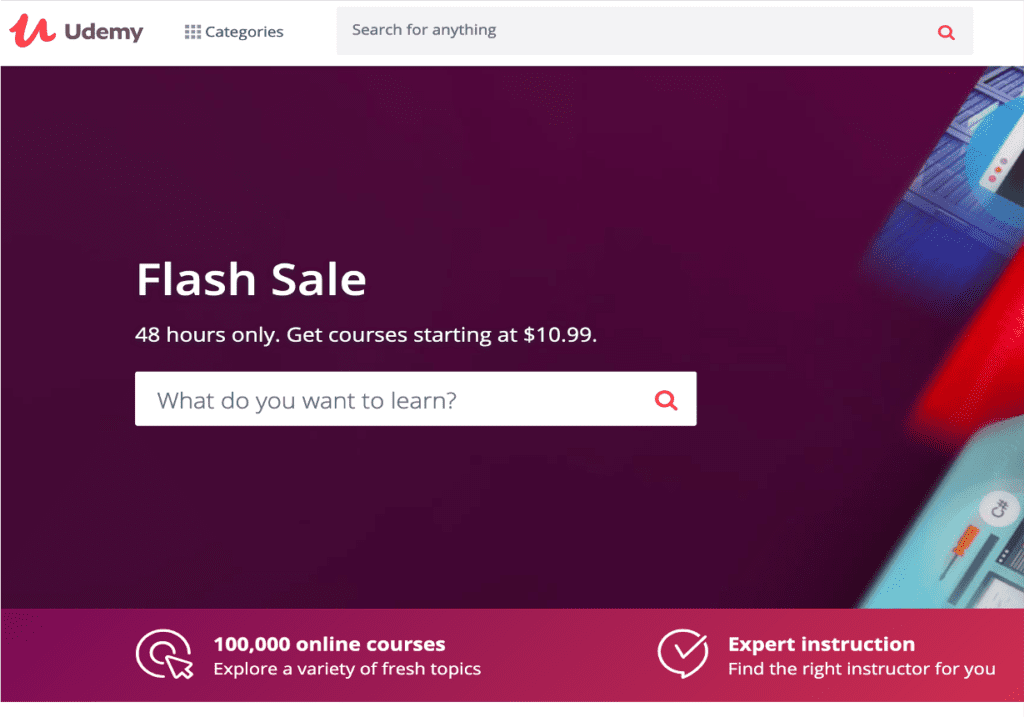

There are dozens of other sites like Udemy, and then just across the web in general, there have to be millions of online courses right now, and you can be pretty sure that no matter what topic you are covering, somebody out there has a course that competes with yours and probably dozens of somebodies, if not hundreds and thousands of somebodies, have courses that compete with yours, so you have to have a way that’s going to stand out and really bring out what’s unique about not just interacting with your content, but interacting with you and with the other people who are using your content.
That’s one thing the effort to build a learning community is going to do for you.
And by the way, in our current environment, with this global pandemic going on, with people having to physical distance, social distance, not be out there as much in their face-to-face communities, people are hungry for community, so you’re providing an opportunity for people who are specifically interested in your topic to come together.
It aligns with modern life and work
Now, another key reason to build a learning community right now is that it really aligns with how modern life and work happen. And this is a great graphic from Heather McGowan. I highly recommended anybody who’s doing any sort of training and education these days follow Heather’s work. You can find her at HeatherMcGowan.com and on Twitter at @heathermcgowan. But she talks about how it used to be that you would get education early in life and get on a standard, linear career path that took you up to retirement and then you’d retire.
That doesn’t happen these days.
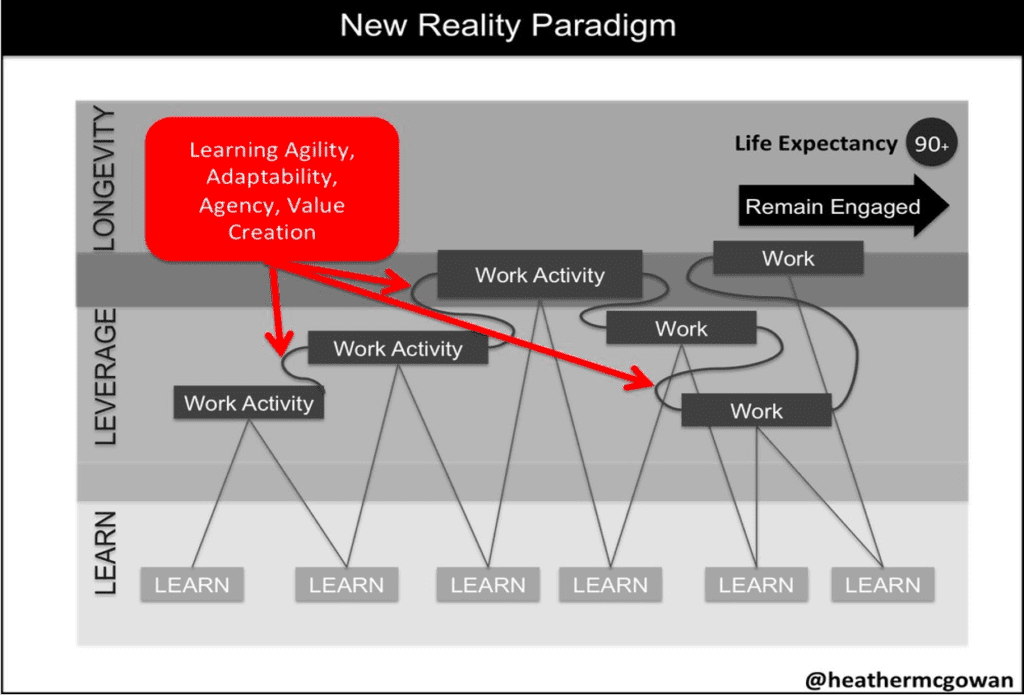

People are in and out of learning all the time. And this is a requirement. It’s a demand of modern life. It’s also a huge opportunity for you, but it’s not one that can be served with just courses alone. If you want to stay with people throughout this cycle that they’re going through throughout their career, a community is a great way to do that because it’s a touchpoint. It’s a place that can always come back to. Even if they don’t happen to be engaged in a course experience with you at a particular point in time, they can engage with you and community.
It drives repeat sales and better products
Now, that points to the next reason to build a learning community that I wanted to raise, and that’s that a community can really help you drive repeat sales to keep people coming back through that cycle we just looked at, and it can also help your drive product strategy.
Now, there’s been research out there for quite a while that says that adding a customer, adding a new customer costs five times as much as keeping a current customer. When you keep those customers close to you through your community, you’re going to be in a much better position to make that next sale rather than if you just let them fall off or rely on just email alone since we know that so many emails never get read, never get opened.
Now, the other thing about this is as you have that community there and as you are able to interact with them and see them interacting with each other, you’re going to get a much clearer idea for what products you should be creating, what should your next courses be.
And I love this quote from Seth Godin, who’s a master of community and a master at online learning himself. We’ll talk about that in a minute. He says,
It’s harder to find people for your products than products for your people.
Seth Godin
If you’ve already got those people, there it’s much, much easier to figure out what to make them. Basically, the point here is that you need to differentiate to be able to compete well. You need to align with modern life and work. And then you’re going to be able to drive repeat sales and product strategy.
Basically, your whole goal with community is that you’re building an asset that goes beyond courses, has value over time and keeps the customers you have engaged with you.
How to Create Community
So, how do we create community? What are the specific sorts of things that we need to be paying attention to if we’re actually going to get people to engage as a community of learners and not just to have a transactional visit and leave or take the course and leave type relationship with us?
Relevancy
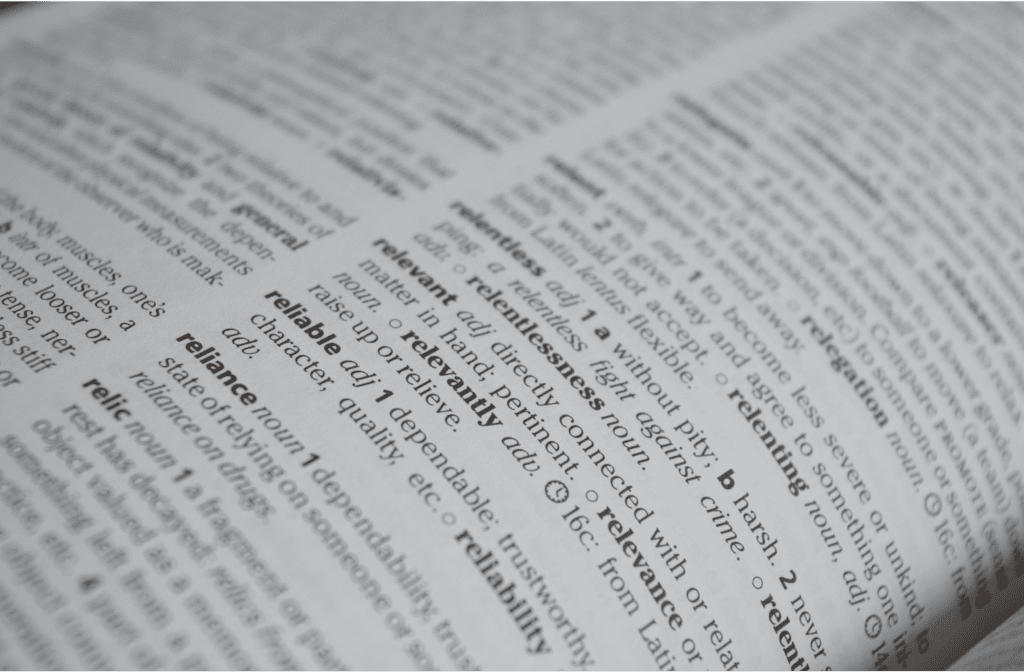

Well, the first thing to keep in mind is relevancy. And this is one that applies really strongly to your online courses.
Of course, it’s absolutely critical with adult learners in general, you need to be offering content that they really feel is relevant. In the case of community, that needs to be the content, but because it’s a community, it also needs to be connections that feel highly relevant to your audience. It needs to be the type of stuff where they’re just going to automatically say, “I can see how this applies and will be useful in my life.”
That sounds like a no-brainer, but it’s often not easy to figure out, and it can require a certain amount of trial and error to learn what’s truly relevant to your audience and makes it worth participating in a community. Both as a way of figuring it out and as a way to keep people engaged once you do figure it out, you need to make sure that the relevance that you provide is recurring, that you don’t just put it out there once. You need to keep doing it again and again. It takes repetition. It takes exposure for people to realize that you do have really relevant stuff out there for you, so if they’re not engaging right away, don’t lose heart. Keep at it.
And then another point is it needs to be facilitated. You can’t just put it out there, the build it and they will come type thing. You have to actually be there highlighting the different content that you’re providing in the community by email, on social media, by all the tools that you have to highlight it, and you need to be connecting specific people who you know already from your experience with them are going to value that content. You need to be connecting people to each other who you know value the same sorts of content and experiences who are sharing those interests, goals and attitudes that we talked about earlier. You really need to be a a catalyst for relevance, both in the content that you create, but then in how you keep putting it out there and how you keep facilitating the interaction with it.
Identity


Another key to community is identity and recognizing that people are going to participate in communities where they really identify with the people who are there. And we all have basically an innate need for belonging, for being a part of groups of others who we feel are like us, and there’s that feeling word again.
Robert Cialdini – you may be familiar with him – he wrote what’s by far the most widely read book on influence. He finally published a follow-up to that book recently in which he added a seventh principle to the six principles of influence he had written about originally, which I believe was back in the ’80s, if my memory serves me right.
That seventh principle was what he calls unity, which is fundamentally about shared identity between you and your community members and between your community members and each other.
And this means that you really need to have a relatively tight focus to your community. It needs to be narrow enough that people feel that sense of identity with others who are participating. And it also means that the community, once again, is not just about you or your content. And in fact, I love this quote from Rich Millington of Feverbee, who’s a real expert on community. He says,
The best content for a community is content about the community.
Richard Millington
So, about the people who are actually in the community, highlighting their successes, highlighting the things that they’re doing that are really working out there and helping them to thrive.
We’re talking about relevancy, we’re talking about identity. Those are critically important, but what you’re striving for with those is what’s really the heart of community, particularly for education providers, for people who are trying to promote learning and that’s social learning.
Social Learning


Social learning what you’re trying to really catalyze in a community environment. And there is a ton of research showing that the vast majority of learning is social. It happens in interactions between people with shared interests and purpose.
And to make that point, you can really think about your own experience. Most of the time when you’re facing some sort of challenge or opportunity, a course really isn’t going to be your default option, at least not as a starting point. You’re probably going to reach out to people or search to find what other people know, what they’re sharing.
Your community, as a course provider, as a learning provider, can give that focused environment for just that sort of connecting with you and with others. And it can help your learners form a tighter bond with you, especially if you offer mainly on-demand courses, and it also really creates leverage for you because learners start interacting with and becoming a resource for each other in an effective community, so that community starts to generate much more learning value than you ever really could on your own.
You just can’t create enough courses or put enough hours in the day to get that sort of multiplier, that exponential effect that you can have from a really engaged community, people interacting with each other and sharing their knowledge and experience.
And another quote that I love from Rich Millington. He says,
The only reason to invest in a community is when you think it can do something you already do much better.
Richard Millington
And this is really what a community does for you. It makes you better as an educator because it really leverages that content that you’ve put into the community as others connect with it and start sharing their real world experiences around it.
So, you really want to develop behaviors in your community that are going to ensure that people will tune in and connect regularly. That’s going back to that relevancy thing. You want to highlight what people are doing, going back to that identity component, and you want them to collectively generate learning, this whole social learning perspective.
Examples of Successful Learning Community
So, then, what does successful community actually look like? Let’s take a quick look at some examples here of where community seems to be working well.
Alan’s Forums
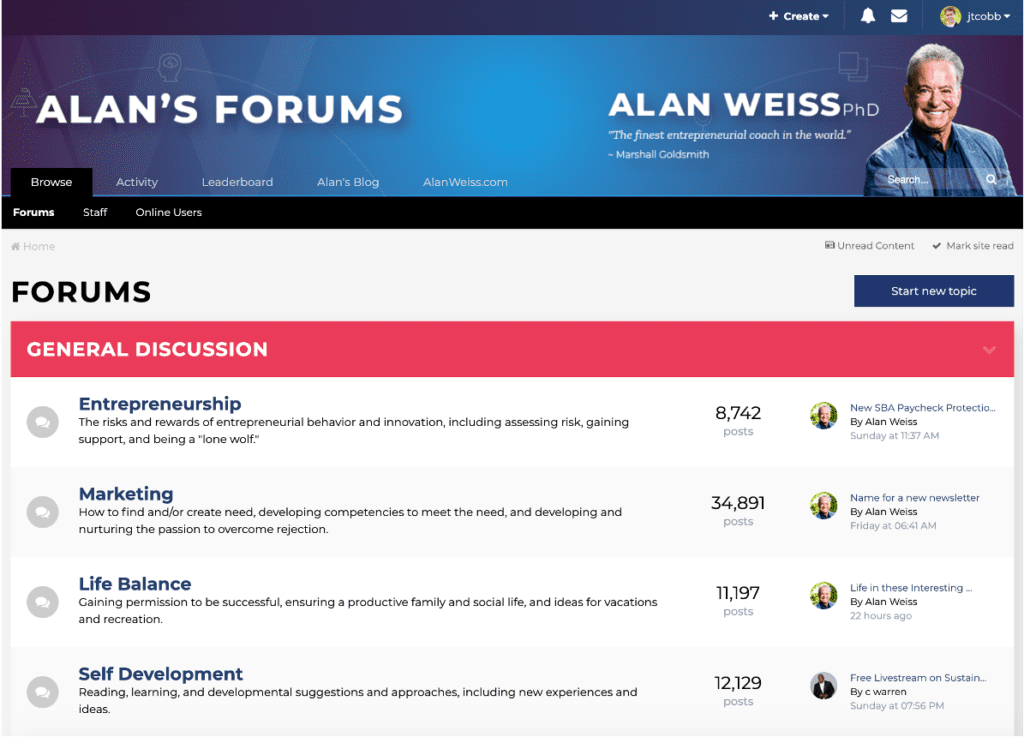

One of the earliest examples for me, a community that I certainly participated in a lot more in the past than I do now because it was just so highly relevant to me at a particular point in time, and this is Alan’s Forums from Alan Weiss.
This is a simple forum software that he set up and he started this, it has to be more than a decade ago. It’s been quite a while ago. He saw early on the power of really forming community with consultants, mostly solo, small consulting firms. He is called the million dollar consultant, so he has this group of people who’ve read his books, who come to his workshops and he saw so much value in pulling them together as a community.
And what he’s done here is set up a simple discussion environment. He’s given it a fairly moderate structure. He’s got these overarching categories that are there, but within the categories, it’s pretty loose. People can do what they want. He’s gotten a ton of user-generated content here. He himself puts a lot of content in. He’s very actively there. We talked about that facilitation earlier. He’s certainly there facilitating. He also has a ton of influence in the community. I mean, this is Alan’s community. It’s his name up there. It’s his picture up there. He’s got a lot of influence, but that’s then being channeled into what users are putting into the community.
And he gets a ton of audience insight out of this. He’s able to see what people are talking about and when he wants to do a new workshop or a new offering, he’ll go in and say, “Okay, if I get at least 15 people,” or whatever his number is, “to sign up for this at X time, X date, then I’ll go ahead and move forward with it,” and he routinely does that and he gets that every time.
I mean, can you imagine doing that for your courses? You’re wondering what to create, you go in and say, “Who’s going to sign up for this if I do it?” And you get however many is your number to do that and you know right away that you can build that and be able to make money off of it. That’s what is happening in Alan’s Forums.
The Marketing Seminar
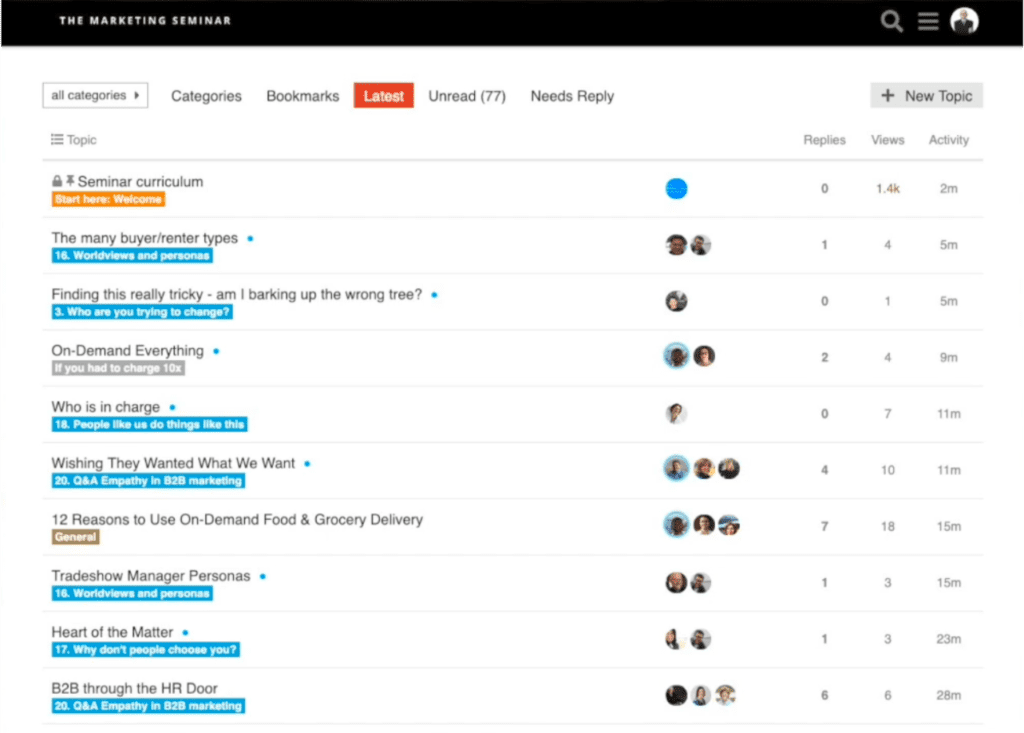

Another example, I mentioned Seth Godin earlier. Many people may not be aware of it, but aside from being this marketing strategy business guru who blogs daily … you may be familiar with Seth and his books … Seth has gotten really into online education over the past probably close to a decade, at least the past several years. He has an MBA, an alternative MBA that he offers and he started offering online courses through a company called Akimbo, A-K-I-M-B-O, that he’s created.
This is an example of his Marketing Seminar that he does online. And it’s got a ton of content and it’s got 60 plus video lessons. These are short clips of Seth himself in most cases talking. This particular one runs over 200 days. It’s a time-limited thing, but it’s taking place over a number of days. And at the very core of it is community.
These discussion boards that you’re seeing (above) are the main thing in the community, and you’ve got Seth’s video content, but the real content is what the learners themselves are putting into it and how they’re interacting with each other and sharing stories. And Seth, because he’s Seth and he has a team of facilitators … I don’t even know if he pays them. They may be volunteers. I’m not sure, but they’re in there making sure that they’re doing what I was talking about earlier, highlighting relevant content on a user by user basis.
They’re using scalable ways to do that obviously, but you’ll get an email or a notice saying, “Hey, look at this piece of content.” They’re connecting people in the community. And then of course, the learners themselves are connecting.
And I tend to think of this as “curriculum as community” because Seth and his team have put a real curriculum structure that drives over this 200 days and a lot of effort into how they’re going to facilitate interaction among that, get that user-generated content within this community. And this happens during the context of this particular course in a time-limited way.
But once you’ve gotten into one of these course communities, you’re going to graduate out into a broader alumni community that Seth and Akimbo run and then you’re going to get some of the same effects there that I just talked about with the Alan Weiss community in terms of really being tuned into your audience and what to offer next.
The Unemployable Initiative
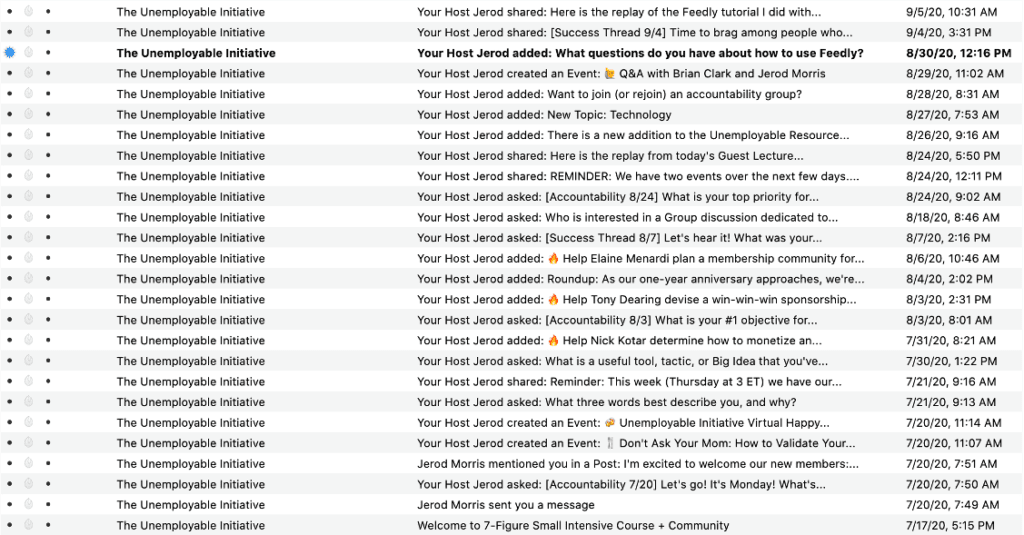

Now, somebody who is extremely tuned into audience and using what his audience tells him, what his community tells him now is Brian Clark with his Unemployable Initiative that he is doing with his partner, Jared Morris.
They’ve set up the Unemployable Initiative as a community site, a paid community site. And now because of the interactions that they’ve seen in the Unemployable Initiative, they’re starting to release course products and coaching products based on what their audience is telling them.
You can see above – this is my email inbox with Jared emailing me about what’s going on in the community. You can see they’re doing a very good job with relevancy, highlighting content, facilitating access to the content and the access to others in the community. You can see where the little flames are that there’s a lot of peer coaching going on, people in the community helping each other out.
You can see that Jared is continually highlighting new events, new content that’s being put into the system. I refer to these as social learning objects, because as soon as you put those objects in and call attention to them, start some discussion around them, they become that basis for discussion. They become the basis for the community. They are a catalyst for community, so you start to thinking about your content and how it’s going to play out in a community context, not just your courses, but videos, guest lectures, things like that, that you might put in there for people to interact around.
And then of course, once again, you’re going to get a ton of audience insight through this. This is really Brian Clark’s whole thing. He’s all about audience first. You figure out what the audience wants and then you build it. And he’s using community now as a very, very powerful way to do that.
The Unemployable Initiative is built on Circle. See our review here.
How to Build a Learning Community – Recap
Now let’s look at the overall points. First of all, you need to provide structure and focus if you’re going to have a successful community, so make sure you’re not just letting it happen. You’re actively structuring it and helping to focus people in according to their identity, according to the relevancy that you’re providing.
You show up consistently. You can see in that inbox shot that I just showed that Jared is showing up consistently. If you look at Alan’s Forums, he’s active there all the time. You need to put those social learning objects into the environment so people do have things to talk about, to react to, to provide their experiences around. You need to facilitate those connections, connections to the content that you’re putting in, but also connections among the people in the community.
And you want to encourage that as a habit. You want to get other people in the community to start thinking about connecting the people that they’ve met as part of the community. You really need to make it about them. Yes, your content is extremely important. You are definitely important as a leadership voice in the community, but you really want to highlight the community members. You saw how Jared was highlighting people’s issues. You’re going to do coaching around that, people helping each other out. He reports successes that people have. They have brag sessions. Make sure you’re doing that sort of thing in the community.
And you want to reward behavior. If somebody is participating actively, what can you do to highlight that, to show their success? Doing things like giving out badges, a digital badge is very popular community now. And if you do that in the right way and you’re really rewarding the sort of behavior that you’re looking for, that can help catalyze more of that behavior.
Now, one question to wrap up on, since I know this can be so important to people that are trying to make a business out of online education is monetization. Should you charge for the community?
Should You Charge for Community?


This is one of those areas that like so many things in business and life, it’s kind of an “it depends” sort of thing, but I can tell you that out of the communities that we just looked at, the examples, Alan Weiss does not currently charge for access to Alan’s Forums, but he used to, and he decided at some point that it was more valuable for him to get more people in there to be able to get that sort of audience insight. You can certainly access it for free at at least some level. You may need to pay to get to a higher levels. I can’t remember how that one works right now, but he definitely has a free way to access that.
For Seth Godin’s, you get into the community by buying a course, by buying one of the seminars that Akimbo offers. That’s how I got into The Marketing Seminar community. But then you are going to graduate into that alumni community that is ongoing and similar sorts of things happen there.
And then finally, for Brian Clark, you can pay to get into the Unemployable Initiative community. It is a community commerce product is how he phrases that. You’ll also get in, at least initially, his first course offering, next level seven. If you sign up for that, community is a bonus. It’s a benefit of signing up for that course and you’ll remain in the Unemployable community, at least for a year. You have to then re-up your membership in that community, but you’re going to pay one way or the other take to get into the Unemployable community right now.
And really it comes down to what you’re trying to do. I think that adding the community as a benefit of courses and making it clear as a benefit is very powerful. Getting to the point of charging just for the community itself, that can be challenging, but if you can get there, obviously, then you’ve created a great product that has a lot of user generation to it so it can take a lot of load off of you. That may not be the place to start. That may be something to do down the line.
And then the free community aspect – if you’ve got a sizable audience and particularly if you don’t quite feel like you know the products that you’re going to create for that audience yet, having that free community can be very advantageous. I would recommend, though, in those cases that if you’re not going to charge, you at least have an application process that people have to go through. Don’t make it too difficult for people to go through, but make sure that you are making it clear what the community is about, what types of relevance you’re going to be offering, just to make sure that you’re getting the right types of people in the community.
That’s basically what I have for why to create an online community, some basics of how to do it. Obviously, this is a very quick overview. We could go much deeper than this, but hopefully this gives you some good ideas of what to be thinking about and then as you start to move into doing community, how you need to be implementing that, what’s actually going to make that community successful. You can contact me easily.
See also:
- How to Architect a Million-Dollar Community with Alan Weiss
- Building Buzzing Communities with Richard Millington
- 10 Best Online Community Platforms
Table of Contents
